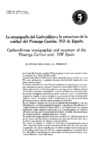Mostrar el registro sencillo del ítem
La estratigrafía del Carbonífero y la estructura de la unidad de Pisuerga-Carrión. NO de España
| dc.contributor.author | Rodríguez Fernández, L. R. | |
| dc.contributor.author | Heredia, N. | |
| dc.date.accessioned | 2010-01-22T13:12:45Z | |
| dc.date.available | 2010-01-22T13:12:45Z | |
| dc.date.issued | 1988 | |
| dc.identifier.citation | Cadernos do Laboratorio Xeolóxico de Laxe, 1988, 12: 207-229 ISSN: 0213-4497 | es_ES |
| dc.identifier.issn | 0213-4497 | |
| dc.identifier.uri | http://hdl.handle.net/2183/6015 | |
| dc.description.abstract | [Resumen] La Unidad del Pisuerga-Carri6n (UPC) constituye la parte más externa (Cuenca de antepaís) de la Zona Cantábrica (ZC). Los materiales silúrico-dev6nicos, con facies más profundas que los del resto de la ZC, están circunscritos a unidades alóctonas desenraizadas emplazadas como mantos gravitacionales. El sistema carbonífero se caracteriza por la presencia de series potentes con notables variaciones de facies y potencias. Durante el Carbotírtero inferior es característica la prensencia de facies homogéneas y una baja tasa de sedimentación en un ambiente claramente preorogénico. A partir del Namuriese se inicia la sedimentación sinorogénica, abundan las facies originadas a partir de pendientes submarinas o ligadas a relieves emergidos. La persistencia de las condiciones sinorogénicas desde el Namuriense hasta el Estefaniense A y la relativa proliferación de discordancias son también rasgos peculiares de éste área. En este trabajo se propone un esquema de unidades litoestratigráficas, a las que informalmente se asigna la categoría de «grupo~, separadas por discordancias y/o conglomerados de continuidad lateral limitada. Se considera que estos «grupos~ representan «cuñas clásticas~ relacionadas con el emplazamiento de unidades alóctonas concretas, por lo que se propone también un modelo relacionando grupos litoestratigráficos y unidades alóctonas o mantos. Se establecen los rasgos generales de la estructura de la UPC diferenciando dos tipos de manta> (gravitacionales y enraizados), así como las relaciones entre éstos y las diversas generaciones de pliegues y esquistosidades. Por último se propone un modelo de evolución tectonosedimentaria para la UPC, claramente ligado a la evolución estructural de toda la ZC como una cadena arqueada, en el que se considera que el carácter centrípeto de las vergencias en la ZC origina estructuras en la UPC con vergencias igualmente centrípetas así como cuñas elásticas, genéticamente relacionadas, con depocentros situados en posiciones distintas a través del tiempo. | |
| dc.description.abstract | [Abstract] The Pisuerga-Carrion Unit (PCU) forms the most external part (foreland basin) of the Cantabrian Zone (Cl). Siluro-devonian rocks with deeper facies than those of the CZ are limited to alloctonous unit wich have been regarded as gravitational nappes. The main characteristic of Carboniferous system is the presence of thick series with remarkable facies and thickness lateral changes. The outstanding feature of lower Carboniferous is the low rate of sedimentation and the fairly uniform sedimentary facies in a preorigenic environment. The synorogenic sedimentation starts in the Namurian, the most frecuent facies are those originated in submarine slopes or those related to subaerial reliefs. The continous synorogenic conditions from Namurian to the Stephanian A stage and the presence of numerous unconformities and lateral sedimentary changes constitue sorne of the characteristics of this area. In this paper a lithostratigraphic sketch are suggested; alllithostratigraphic units were integrated in higher rank units informally called «groups». These «groups» are separated by conglomerates and /or unconformities of limited lateral extension and would represent clastic wedges generated in the front of the nappes Both clastic wedges and nappes are related in this sketch. The general features of the PCU structure are found and two types of nappes (generated by gliding and /or spreading) are stablished, in this way, severa! Generations of folds and cleavages are related with both types of nappes. Lately a tectonosedimentary evolution model for the PCU which would be directly linked to the structural evolution of the Cl. The centripetal character of the vergences in the Cl produced structures (nappes and related folds) in the PCU that have an equally centripetal vergence and originated a synorogenic clastic wedges with depocenters located, in time, in several positions. | |
| dc.language.iso | spa | es_ES |
| dc.publisher | Universidade da Coruña | es_ES |
| dc.subject | Carbonífero | es_ES |
| dc.subject | Estratigrafía | es_ES |
| dc.subject | Tectónica | es_ES |
| dc.subject | Manto | es_ES |
| dc.subject | Cuña clástica | es_ES |
| dc.subject | Sinorogénico | es_ES |
| dc.subject | Tectonosedimentario | es_ES |
| dc.subject | Carboniferous | es_ES |
| dc.subject | Stratigraphie | es_ES |
| dc.subject | Tectonic | es_ES |
| dc.subject | Nappe | es_ES |
| dc.subject | Clastic wedge | es_ES |
| dc.subject | Synorogenic | es_ES |
| dc.subject | Tectonosedimentary | es_ES |
| dc.title | La estratigrafía del Carbonífero y la estructura de la unidad de Pisuerga-Carrión. NO de España | es_ES |
| dc.title.alternative | Carboniferous stratigraphie and structure oí the Pisuerga-Carrion unit. NW Spain | |
| dc.type | info:eu-repo/semantics/article | es_ES |
| dc.rights.access | info:eu-repo/semantics/openAccess |






